 |
 The Virtual Corkscrew Museum's Weekly Newspaper |
 |
 |
 The Virtual Corkscrew Museum's Weekly Newspaper |
 |
|
Monday, August 24, 2009 |
Number 571 |
Samuel Henshall (1765-1807)
Through his diligent research, Fletcher Wallis (above left), author of British Corkscrew Patents from 1795, the burial place of the Reverend Samuel Henshall was found. Rev. Henshall was awarded the first patent for a corkscrew in 1795 in England. Henshall is buried in London's Bow Church where he was the Rector. On August 24, 2009, the International Correspondence of Corkscrew Addicts (ICCA) visited Bow Church to present and dedicate a commemorative plaque. The ceremony was led by the eloquent Reverend Michael Peet who was pleased to note that such a noble instrument has ties to his Church and further suggests that the inventor of the screw cap should be relegated to Hell.
Bert Giulian, author of Corkscrews of the Eighteenth Century, spoke of Henshall and some of his piratical dealings suggesting that Henshall quite likely patented what was already known corkscrew technology. Fletcher Wallis unveiled to plaque to the pleasure of all attending.
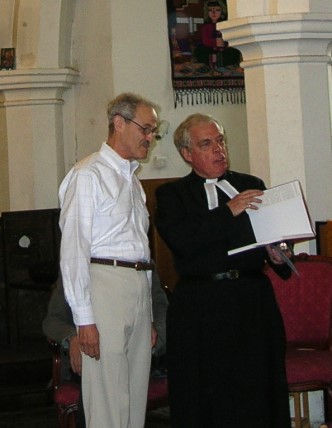
Author Giulian presents Rev. Peet with a copy of his book.
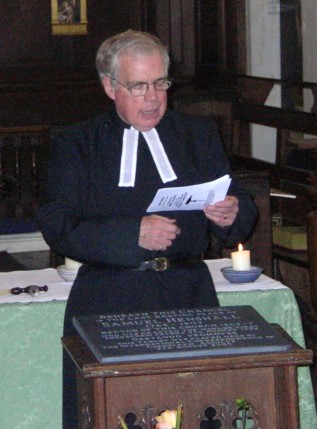
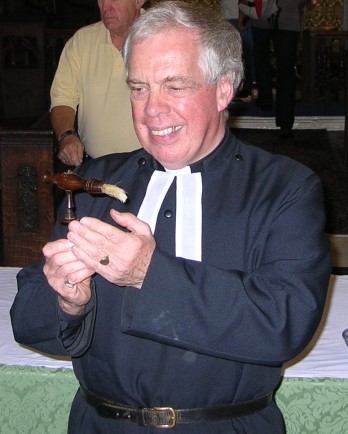
Left: Rev. Peet reads Psalm 104.15 "Wine that maketh glad the heart of man."
Right: Rev. Peet admires a Henshall type corkscrew (not original Henshall)

Right Fred Kincaid, Bert Giulian, Fletcher Wallis, Rev. Peet
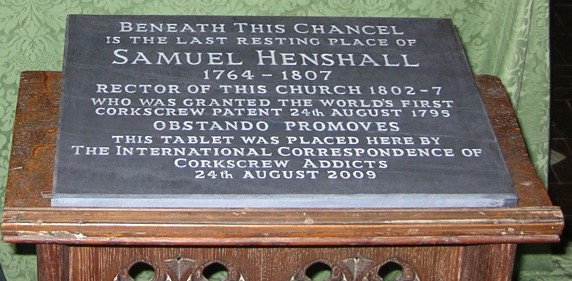
The Plaque
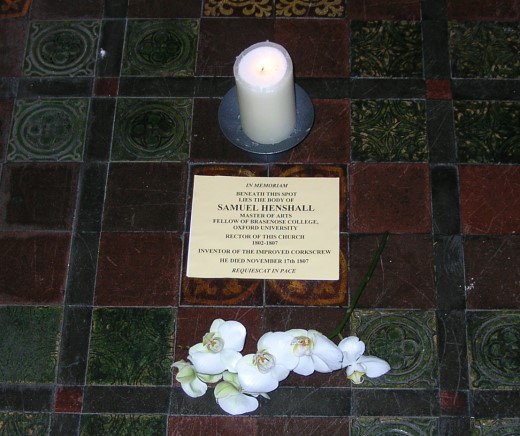
The burial place
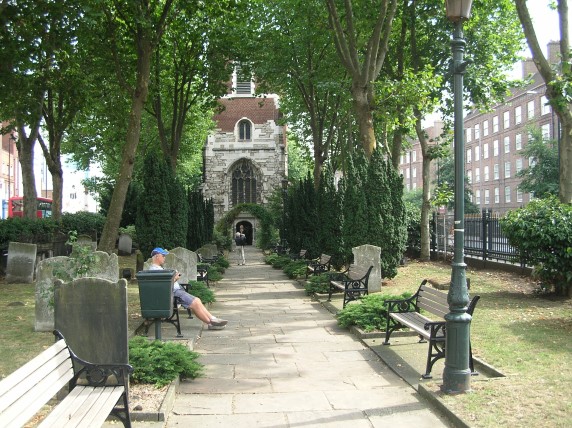
Entrance to Bow Church on August 26, 2009
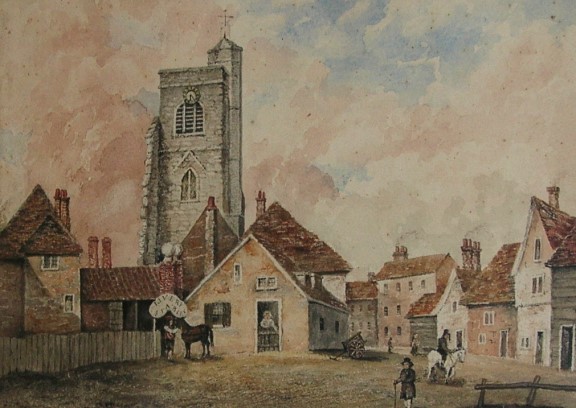
Bow Church as Henshall would have known it
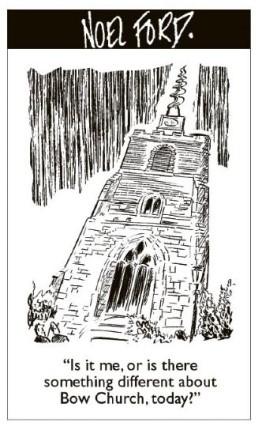
Noel Ford's view of Bow Church!
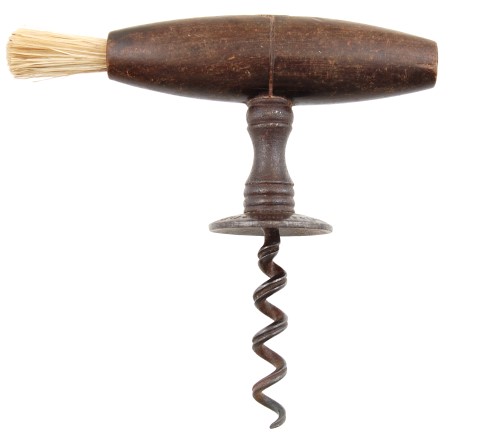
Original Henshall Corkscrew
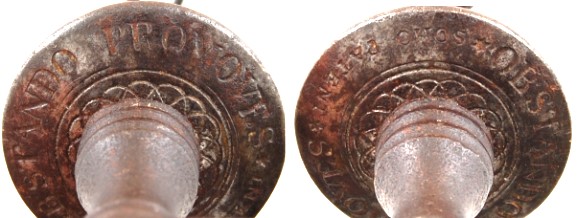
Markings on the Henshall button OBSTANDO PROMOVES - SOHO PATENT
The Church Times
The Weekly Screw editor's note: This article appeared in the Church Times on August 21, 2009.
Enthusiasts turn up to honour clergy twister by Pat Ashworth
CORKSCREW ADDICTS from around the world will gather in Bow Church, east London, on Monday to honour the Revd Samuel Henshall, Rector from 1802-1807, and inventor of what he called the “piratical screwmaker”.
Professor Henshall, an Oxford academic in the field of Anglo-Saxon, died in 1807, and is buried in the chancel of the 700-year-old church.
He described his new invention in a letter to the Birmingham metalsmith, Matthew Boulton, as “a new Mode of applying the Screw, and a Mode which every Person who sees it will be surprised that he himself did not find out”.
Boulton, who worked on early steam-engine design with James Watt, manufactured the corkscrew for Professor Henshall in one of his factories. A circular cap at the base of the worm (i.e. screw) prevents it from going too deep into the cork, and also forces the cork to turn, thus breaking any seal it has formed with the bottle neck. Professor Henshall boasted that it would have the power to extract “the hardest, tightest or most decayed Cork”, and would rapidly supersede its rivals.
Members of the International Correspondence of Corkscrew Addicts (ICCA) will visit his grave and present a plaque in his memory. The ICCA, whose membership is strictly limited to 50, held its first meeting at the Guinness Brewery in 1974, organised by Dr Bernard Watney, its first Chief Correspondent. A Californian monk, Timothy Diener, who made wine for the Christian Brothers, was its first chaplain.
Applicants to the closely knit group must specify “size and nature of collection, number of years collecting, how addiction was developed, and any research done”, as well as supplying biographical information.
The Rector of Bow, the Revd Michael Peet, will dedicate the plaque at 10 a.m. on Monday, the exact anniversary of the granting of the patent in 1795. “This must surely be a unique event in the 700-year history of the church,” he suggested. “I hope the ‘Addicts’ bring a couple of Henshall corkscrews with them so that we can raise a glass to my illustrious predecessor.”
Wine has long been a feature of the Church’s spiritual and recreational life. Is there a corkscrew in your vestry?
The Londonist
The Weekly Screw editor's note: This article appeared in the Londonist on August 17, 2009.
Corkscrew Celebration At Bow Church
You know you've found a very special local news report when the first two words are 'Corkscrew enthusiasts'. Is this some fashionable sexual position? A call out to fans of the defunct Alton Towers roller coaster? Nope. It really is a piece about aficionados of helical implements. Members of the International Correspondence of Corkscrew Addicts (which claims to be the most prestigious corkscrew collector organization in the world) will next week gather at Bow Church to honour their spiritual founder.
Samuel Henshall, a former rector of that church, first patented the corkscrew back in 1795. The ICCA will present a plaque to this leader of men on 24 August, the anniversary of the patent grant. "I hope the 'Addicts' bring a couple of Henshall corkscrews with them so we can raise a glass to my illustrious predecessor," the current Rector told the East London Advertiser.
If you're thinking about joining the ICCA, you might want to check out their rather sinuous application process. Extract: "A photograph and detailed description of what [the] applicant regards as his/her six best corkscrews should be enclosed. Research is highly regarded as [for?] membership eligibility as the ICCA has as one of its goals the finding and disseminating of corkscrew related information." Good to know that British eccentricity is alive and well.
Brasenose College, University Oxford
The Weekly Screw editor's note: This article appeared in the Brasenose College news.
Rev. Samuel Henshall, Corkscrew Inventor, Remembered
Monday 24th August 2009, 214 years to the day after Rev. Samuel Henshall (BNC 1782) was the first man to be granted a patent on a corkscrew, a plaque was unveiled in his honour. The carved stone tablet will be installed in the church of which Henshall was Rector and where he was buried: St. Mary's Church in Bow. 'Bow Church' was a scene of celebration and remembrance as fifty corkscrew enthusiasts from around the world gathered to honour a forefather of the corkscrew fraternity.
The International Correspondence of Corkscrew Addicts (ICCA), an exclusive organisation of just fifty members founded in 1974, chose to honour Henshall with a new plaque commending to history his place in the development of the corkscrew. Bow Church, celebrating its septcentenary in 2012, lies near the East End site of the London Olympic Games which will take place in the same year. The current Rector, Rev. Michael Peet, welcomed the visitors to his church and said how pleased he was to have a famous and enterprising forebear. Fletcher Wallis, Bert Giulian and Fred Kincaid from the ICCA went on to talk about Henshall's work and the importance of his invention in corkscrew evolution. The service concluded with a toast of wine from bottles opened with an original Henshall corkscrew.
Samuel Henshall, the son of a Cheshire grocer, was born in 1765. Educated first at Manchester Grammar School, he went up to Brasenose as a Somerset Scholar in 1782 and gained his MA in 1789 shortly before his ordination. Henshall was made a Fellow of the College but his academic career was not as illustrious as he had hoped: his dense scholarly works received a mixed reception and his bid, in 1800, to become Oxford's Professor of Anglo-Saxon was unsuccessful. He became a Curate of Christ Church, Spitalfields, and from 1802 until his death in 1807, he held the post of Rector of St. Mary's which, at that time, was one of the College's livings.
In May 1795, Henshall approached Matthew Boulton, the famous Birmingham entrepreneur, to arrange for the manufacture of the corkscrew which he claimed to have invented. Henshall's design included a concave ‘button', fixed between screw and shank, which prevented the screw penetrating too far into the bottle and simultaneously gripped the cork to break its seal with the neck of the bottle. Similar corkscrews were, however, already in existence leading to attacks on Henshall's claim to be the inventor: most famously, he was called a ‘piratical screwmaker' in an 1829 work which attributed the design to one ‘Miss O'Rourke'.(1)
Boulton clearly took to the idea and Henshall stayed a fortnight with him while they developed the design. However, Henshall was not an ideal business partner: he was clearly having financial problems and did not put up his portion of the patent expenses. Boulton's legal advisor wrote in 1795: 'I doubt I shall not so easily extract £50 from the Parson, as he would a Cork from a Bottle.'(2) Within five years, there is evidence of further money woes as Henshall appeared in court three times being sued for the recovery of debts, the largest amount - some £420 - payable to a brewer. It is said that the remaining stock of corkscrews was buried with Henshall in the chancel of Bow Church.
(1): Giulian, Corkscrews of the Eighteenth Century, 159.
(2): Giulian, Corkscrews of the Eighteenth Century, 152.
|
©2009 Don Bull, Editor |